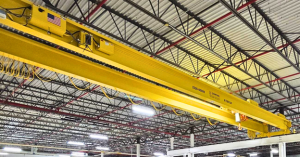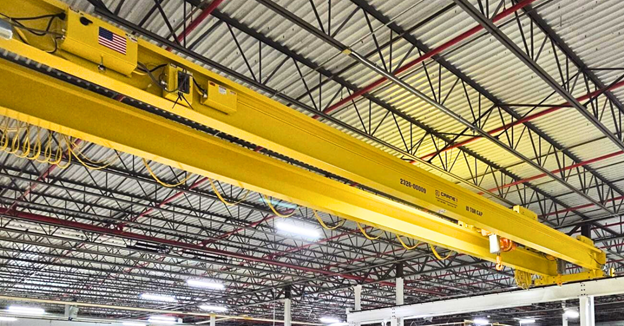For businesses that rely on material handling, overhead cranes represent indispensable assets. They streamline operations, enhance safety, and contribute significantly to overall productivity. However, like any piece of capital equipment, overhead cranes eventually age, become less efficient, and require increasing maintenance.
At Crane 1 Services, we understand that the investment on a new overhead crane is a significant one. Therefore, it is crucial to thoroughly assess the potential return on investment before committing to such an expenditure. This comprehensive article will guide you through the process of evaluating the financial benefits of modernizing your crane system.

Understanding the Need for Crane Modernization
Before delving into the specifics of return on investment (ROI) calculation, it is important to understand the factors that necessitate crane modernization. Several indicators suggest that your existing crane may be hindering your operations and impacting your bottom line. These include:
- Increased Downtime – Older cranes are more susceptible to mechanical failures, leading to unplanned downtime. This disrupts production schedules, delays shipments, and can result in significant financial losses.
- Higher Maintenance Costs – As cranes age, the frequency and cost of repairs tend to escalate. Sourcing obsolete parts can be challenging and expensive, further contributing to operational expenses.
- Reduced Efficiency – Older crane technology may lack the speed, precision, and control of modern systems. This can lead to slower cycle times, increased material handling times, and reduced overall efficiency.
- Safety Concerns – Outdated cranes may not incorporate the latest safety features, increasing the risk of accidents and potential liability. Compliance with current safety regulations may also become an issue.
- Limited Capacity and Functionality – Your existing crane may no longer meet your evolving operational needs in terms of lifting capacity, span, or specialized functions.
- Energy Inefficiency – Older crane motors and control systems can consume significantly more energy compared to modern, energy efficient alternatives.
Recognizing these limitations is the first step in understanding the potential benefits of investing in a new, modernized overhead crane.
Identifying the Key Components of Return on Investment
Calculating the ROI of a new overhead crane involves quantifying both the costs associated with the investment and the financial benefits it is expected to generate. The basic formula for ROI is:
(Net Benefit – Cost of Investment) / Cost of Investment x 100%
To accurately apply this formula, we need to identify and quantify the various costs and benefits associated with crane modernization.
Quantifying the Costs of Investment
The initial cost of a new overhead crane is the most obvious expense. However, a comprehensive assessment of investment costs should also include:
- Purchase Price of the New Crane – This includes the base cost of the crane, trolley, hoist, and any standard accessories.
- Installation Costs – These encompass the expenses related to the physical installation of the new crane, including rigging, electrical work, structural modifications (if necessary), and labor.
- Training Costs – Investing in training for your operators and maintenance personnel on the new crane system is crucial for safe and efficient operation.
- Disposal Costs of the Old Crane – Depending on its condition and market value, you may incur costs associated with dismantling and disposing of your existing crane.
- Initial Spare Parts Inventory – Maintaining a small inventory of critical spare parts can minimize downtime in the initial stages of operation.
Quantifying the Benefits of Investment
The benefits of a new overhead crane can be categorized into tangible and intangible factors. While intangible benefits like improved employee morale are important, the ROI calculation primarily focuses on quantifiable financial gains. These include:
- Reduced Downtime Costs – A new, reliable crane will significantly reduce unplanned downtime. Calculate the cost of downtime based on lost production, idle labor, and potential penalties for delayed shipments. Estimate the reduction in downtime with a new crane and quantify the savings.
- Lower Maintenance Costs – Modern cranes are designed for increased reliability and often require less frequent and less costly maintenance. Estimate the reduction in annual maintenance expenses, including parts and labor.
- Increased Productivity – A new crane with improved speed, precision, and control can significantly enhance material handling efficiency. Quantify the increase in throughput, reduced cycle times, and the resulting increase in production capacity.
- Energy Savings – Modern crane technology often incorporates energy efficient motors, variable frequency drives, and regenerative braking systems. Calculate the potential reduction in energy consumption and the associated cost savings.
- Improved Safety and Reduced Liability – New cranes are equipped with advanced safety features, minimizing the risk of accidents and potential liability costs, including insurance premiums and legal expenses. While difficult to predict precisely, consider the potential financial impact of a serious accident.
- Increased Lifting Capacity and Functionality – If the new crane offers increased lifting capacity or new functionalities, quantify the potential for handling larger loads, accessing new markets, or streamlining specific processes.
- Improved Inventory Management – More precise material handling can lead to better inventory control, reducing waste and improving efficiency in warehouse operations.
- Potential for Higher Resale Value – While not an immediate benefit, a newer crane in good condition will likely have a higher resale value compared to an older, less efficient model.
Calculating the Return on Investment
Once you have diligently quantified both the costs and the benefits, you can proceed with the ROI calculation.
- Calculate the Total Cost of Investment – Sum all the costs associated with acquiring and implementing the new overhead crane.
- Estimate the Total Net Benefit – For a specific timeframe (e.g., 5 or 10 years), project the annual benefits and subtract any ongoing operational costs associated with the new crane (e.g., slightly higher energy consumption for increased usage). Then, sum the net benefits over the chosen timeframe.
- Apply the ROI Formula – Divide the total net benefit by the total cost of investment and multiply by 100% to express the ROI as a percentage.
Example Scenario:
Let us consider a hypothetical manufacturing company:
- Total Cost of New Crane (including installation and training): $250,000
- Estimated Annual Reduction in Downtime Costs: $30,000
- Estimated Annual Reduction in Maintenance Costs: $15,000
- Estimated Annual Increase in Productivity (leading to increased revenue): $40,000
- Estimated Annual Energy Savings: $5,000
Over a five year period, the total net benefit would be:
($30,000 + $15,000 + $40,000 + $5,000) x 5 years = $450,000
The ROI would then be calculated as:
($450,000 – $250,000) / $250,000 x 100% = 80%
This indicates a significant return on investment over the five year period.
Beyond the Simple ROI Calculation
While the basic ROI formula provides a valuable initial assessment, consider other financial metrics for a more comprehensive evaluation:
- Payback Period – This calculates the time it takes for the cumulative benefits to equal the initial investment. A shorter payback period is generally more desirable.
- Net Present Value (NPV) – This method considers the time value of money by discounting future cash flows back to their present value. A positive NPV indicates that the investment is expected to be profitable.
- Internal Rate of Return (IRR) – This is the discount rate at which the NPV of the investment equals zero. A higher IRR generally indicates a more attractive investment.
Consulting with financial professionals can help you apply these more advanced metrics to your specific situation.
The Importance of Accurate Data and Realistic Projections
The accuracy of your ROI assessment heavily relies on the quality of the data you use for cost and benefit estimations. It is crucial to:
- Gather Historical Data – Analyze past maintenance records, downtime logs, and production figures for your existing crane.
- Obtain Detailed Quotes – Secure comprehensive quotes from reputable crane manufacturers and installation service providers like Crane 1 Services.
- Consult with Experts – Leverage the knowledge and experience of your operations team, maintenance personnel, and crane specialists.
- Make Realistic Projections – Avoid overly optimistic estimates of benefits. Base your projections on realistic operational improvements and market conditions.
Partnering with Crane 1 Services for Your Modernization Journey
At Crane 1 Services, we are committed to providing our clients with not only high quality overhead cranes but also the expertise and support needed to make informed investment decisions. Our team can assist you in:
- Assessing your current crane system and identifying areas for improvement.
- Providing detailed specifications and cost estimates for new crane solutions tailored to your specific needs.
- Offering insights into the potential benefits and ROI of modernizing your crane system.
- Ensuring seamless installation, comprehensive training, and ongoing support for your new crane.
Investing in a new overhead crane is a strategic decision that can significantly impact your operational efficiency, safety, and profitability. By carefully assessing the return on investment, you can make a confident and well-informed choice that will benefit your business for years to come.
Contact Crane 1 Services today to explore your crane modernization options and begin your journey towards enhanced material handling capabilities.
